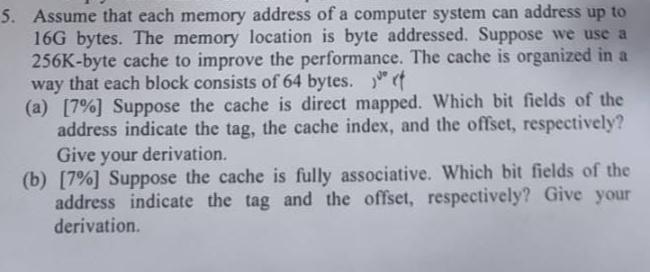Question
5. Assume that each memory address of a computer system can address up to 16G bytes. The memory location is byte addressed. Suppose we

5. Assume that each memory address of a computer system can address up to 16G bytes. The memory location is byte addressed. Suppose we use a 256K-byte cache to improve the performance. The cache is organized in a way that each block consists of 64 bytes.f (a) [7%] Suppose the cache is direct mapped. Which bit fields of the address indicate the tag, the cache index, and the offset, respectively? Give your derivation. (b) [7%] Suppose the cache is fully associative. Which bit fields of the address indicate the tag and the offset, respectively? Give your derivation.
Step by Step Solution
There are 3 Steps involved in it
Step: 1

Get Instant Access to Expert-Tailored Solutions
See step-by-step solutions with expert insights and AI powered tools for academic success
Step: 2

Step: 3

Ace Your Homework with AI
Get the answers you need in no time with our AI-driven, step-by-step assistance
Get StartedRecommended Textbook for
The Architecture of Computer Hardware, Systems Software and Networking An Information Technology App
Authors: Irv Englander
5th edition
1118322630, 978-1118322635
Students also viewed these Programming questions
Question
Answered: 1 week ago
Question
Answered: 1 week ago
Question
Answered: 1 week ago
Question
Answered: 1 week ago
Question
Answered: 1 week ago
Question
Answered: 1 week ago
Question
Answered: 1 week ago
Question
Answered: 1 week ago
Question
Answered: 1 week ago
Question
Answered: 1 week ago
Question
Answered: 1 week ago
Question
Answered: 1 week ago
Question
Answered: 1 week ago
Question
Answered: 1 week ago
Question
Answered: 1 week ago
Question
Answered: 1 week ago
Question
Answered: 1 week ago
Question
Answered: 1 week ago
Question
Answered: 1 week ago
Question
Answered: 1 week ago
Question
Answered: 1 week ago
Question
Answered: 1 week ago
Question
Answered: 1 week ago
View Answer in SolutionInn App



